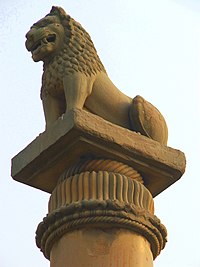The Marvel of the Dhamma
Ashoka Maurya


Silver punch-mark coins of the Mauryan empire, bear Buddhist symbols such as the Dharmacakra,
the elephant (previous form of the Buddha), the tree under which
enlightenment happened, and the burial mound where the Buddha died
(obverse). 3rd century BC.
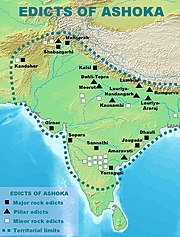

Greek Late Archaic style capital from Patna (Pataliputra), thought to correspond to the reign of Ashoka, 3rd century BC, Patna Museum (click image for references).
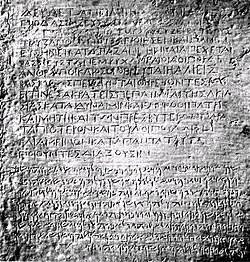
Bilingual edict (Greek and Aramaic) by king Ashoka, from Kandahar - Afghan National Museum. (Click image for translation).


“The legend of King Asoka, A study and translation of the Asokavadana“, John Strong, Princeton Library of Asian translations.


This is the famous original sandstone sculpted Lion Capital of Ashoka preserved at Sarnath Museum which was originally erected around 250 BCE atop an Ashoka Pillar at Sarnath. The angle from which this picture has been taken, minus the inverted bell-shaped lotus flower, has been adopted as the National Emblem of India showing the Horse on the left and the Bull on the right of the Ashoka Chakra in the circular base on which the four Indian lions
are standing back to back. On the far side there is an Elephant and a
Lion instead. The wheel “Ashoka Chakra” from its base has been placed
onto the center of the National Flag of India.
Those who practice the Dhamma will begin
to know the Dhamma or to gain a feel for the Dhamma in the area of
meditation more markedly than in other areas, and more extensively. For
example, the gratification that comes from being generous is moving in
one way, the gratification that comes from maintaining the precepts is
moving in another way, the feelings of gratification that come from the
different forms of goodness are moving in their own separate ways. This
is called finding gratification in skillfulness.
But
all of these feelings of gratification converge in the practice of
meditation. We begin to feel moved from the moment the mind begins to
grow still, when the heart gathers its currents together to stand
solely on its own. Even though we may not yet obtain a great deal of
stillness from the inward gathering of the mind, we still find
ourselves gratified within, in a way we can clearly sense. If the mind
or the Dhamma were a material object, there wouldn’t be anyone in the
world who wouldn’t respect the religion, because the goodness, the
well-being, and the marvels that arise from the religion and from the
practicing in line with the teachings of the religion are things
desired the world over.
Goodness, well-being,
marvels: These are things the world has always desired from time
immemorial — with a desire that has never lost its taste — and they are
things that will always be desired until the world loses its meaning,
or until people become extinct, having no more sense of good and evil.
That’s when the world will no longer aspire for these great blessings.
The well-being that comes from the marvels — the Dhamma in the area of
its results — is something to which all living beings aspire, simply
that their abilities differ, so that some attain their aspirations,
while others don’t.
But the Dhamma can’t be
displayed for the world to perceive with its senses of sight, hearing,
smell, taste, or touch in the way other things can. Even though there
may be other immaterial phenomena similar to the Dhamma — such as
smells — still they aren’t like the true Dhamma that is touched by the
hearts of those who have practiced it. If the Dhamma could be displayed
like material objects, there is no doubt but that the human world would
have to respect the religion for the sake of that Dhamma. This is
because the Dhamma is something more marvelous than anything else. In
all the three levels of existence, there is no greater marvel than in
the Dhamma.
The Dhamma can appear as a
marvel, conspicuous and clear in the mind. The mind is what knows it —
and only the mind. It can’t be displayed in general like material
objects, as when we take things out to admire or to show off to others.
The Dhamma can’t possibly be displayed like material objects. This is
what makes the world lack interest — and lack the things that could be
hoped from the Dhamma — in a way that is really a shame.
Even
those who want the marvel of the Dhamma don’t know what the marvel is,
or what the profundity of the Dhamma is, because the mind has never had
contact with that profundity. The eye has never had contact with the
marvel. The ear has never obtained any marvel from the current of the
Dhamma, because the Dhamma can’t be displayed as a current of sound as
other things can. This is one obstacle that prevents people from
becoming moved by the Dhamma, that prevents them from fully believing
and fully entrusting themselves to the Dhamma in a way consistent with
the world’s long-felt hunger for well-being and prosperity.
Each
of the Buddhas who has gained Awakening and taught the Dhamma to the
world has had to reflect to the full extent of his intelligence and
ability on the myriad ways of teaching the Dhamma to the world so that
the world could see it as a marvel, inasmuch as the Dhamma can’t be put
in shop windows or in public places. This is because the true Dhamma
lies in the heart and reveals itself only in words and deeds, which
doesn’t excite a gratifying sense of absorption in the same way as
touching the Dhamma directly with the heart.
Because
there is no way to display the Dhamma directly, the Buddhas display it
indirectly through teaching. They point out the causes — the Dhamma of
conduct and practices leading to the Dhamma of results at this or that
point or this or that level; and at the same time they proclaim the
results — the excellence, the marvels of the stages and levels of the
Dhamma that can be touched with the heart, all the way to the highest
marvel, vimutti, the mental release called nibbana within the heart.
Every
Buddha has to devise strategies in teaching the Dhamma so as to bring
that marvel out to the world by using various modes of speech and
conduct — for example, describing the Dhamma and showing the conduct of
the Dhamma as being like this and that — but the actual Dhamma can’t be
shown. It is something known exclusively in the heart, in the way in
which each Buddha and each arahant possesses this marvel. None of the
Buddhas, none of the arahants who possess this marvel are in any way
deficient in this regard.
The marvel lies in
their hearts — simply that they can’t take the marvel that appears
there and display it in the full measure of its wonder. Thus they
devise strategies for displaying it in their actions, which are simply
attributes of the Dhamma, not the actual Dhamma itself. For instance,
the doctrine they teach in the texts is simply an attribute of the
Dhamma. Their act of teaching is also just an attribute of the Dhamma.
The actual Dhamma is when a meditator or a person who listens to their
teachings about the Dhamma follows the Dhamma in practice and touches
it stage by stage within his or her own heart. This is called beginning
to make contact with the actual Dhamma, step by step. However much
contact is made, it gives a sense of gratification felt exclusively
within the heart of the person who has gained that contact through his
or her own practice.
When it comes to
ingenuity in teaching, no one excels the Buddhas. Even so, they reveal
only what they see as appropriate for humanity. They can’t reveal the
actual Dhamma — for example, by taking out the true marvel in their
hearts and unfolding it for the world to see, saying, ‘This is the
marvel of the Tathagata, of each Buddha. Do you see it?’ This can’t be
done, for here we’re talking about the marvel of the purity of a heart
that was previously swamped with defilement like a heap of assorted
excrement, but now has become a pure, unsullied nature, or a pure,
amazing nature because of the practice of constantly and relentlessly
cleansing it. They can’t show that Dhamma to the world, saying, ‘Do you
see this? Look at it. Look at it. Feast your eyes till they’re full and
then strive to make this treasure your own!’ So instead, they teach by
using various strategies for those who practice, describing the path in
full detail, in terms both of causes and of results.
What
they bring out to show is simply the current of their voices, the
breath of their mouths. That’s what they bring out to speak, simply the
breath of their mouths. They can’t bring out the real thing. For
example, when they say, ‘It’s marvelous like this,’ it’s just sound.
The marvelous nature itself can’t be brought out. All they can bring
out is the action of saying, ‘That nature is marvelous,’ so that we can
speculate for ourselves as to what that marvel is like. Even though
this doesn’t remove our doubts, it’s better than if we had never heard
about it at all.
But the basic principle in
making us come to know and see the marvel of the Dhamma is that first
we have to speculate and then we follow with practice. This qualifies
as following the principles of the Dhamma the Buddha taught, and this
is fitting and proper. No matter what the difficulties and hardships
encountered in following the path, we shouldn’t let them form barriers
to our progress, because this is where the path lies. There are no
other byways that can take us easily to the goal. If our practice is
difficult, we have to stick with it. If it’s painful, we have to bear
it, because it’s a duty we have to perform, a burden we have to carry
while working so as to attain our aims.
The
Dhamma of a pure mind is like this: The mind is the Dhamma, the Dhamma
is the mind. We call it a mind only as long as it is still with the
body and khandhas. Only then can we call it a pure mind, the mind of a Buddha, or the mind of an arahant. After it passes from the body and khandhas, there is no conventional reality to which it can be compared, and so we can’t call it anything at all.
No
matter how marvelous that nature, no matter how much it may be ours,
there is no possible way we can use conventional realities to describe
it or to make comparisons, because that Dhamma, that realm of release,
has no conventions against which to measure things or make comparisons.
It’s the same as if we were in outer space: Which way is north, which
way is south, we don’t know. If we’re on Earth, we can say ‘east,’
‘west,’ ‘north,’ and ’south’ because there are things that we can
observe and compare so as to tell which direction lies which way. We
take the Earth as our standard. ‘High’ and ‘low’ depend on the Earth as
their frame of reference. How much higher than this, lower than this,
north of this, south of this: These things we can say.
But
if we’re out in outer space, there is no standard by which we can
measure things, and so we can’t say. Or as when we go up in an
airplane: We can’t tell how fast or how slow we’re going. When we pass
a cloud, we can tell that we’re going fast, but if we depend simply on
our eyesight, we’re sure to think that the speed of the airplane is
nowhere near the speed of a car. We can clearly see how deceptive our
eyesight is in just this way. When we ride in a car, the trees on both
sides of the road look as if they were falling in together down on the
road behind us. Actually, they stay their separate selves. It’s simply
that the car runs past them. Since there are things that we sense, that
lie close enough for comparison, it seems as if the car were going
really fast.
As for the airplane, there’s
nothing to make comparisons with, so it looks as if the plane were
dawdling along, as if it were going slower than a car, even though it’s
actually many times faster.
This is how it is when we compare the mind of an ordinary run-of-the-mill person with the mind of the Buddha. Whatever the Buddha says is good and excellent, we ordinary people tend to say that it’s not.
Whatever we like, no matter how vile, we say that it’s good. We don’t
admit the truth, in the same way as thinking that a car goes faster
than an airplane.
The practice of attending to the mind is something very important. Try to develop mindfulness (sati)
and discernment so that they can keep up with the things that come and
entangle the mind. By and large, the heart itself is the instigator,
creating trouble continually, relentlessly. We then fall for the
preoccupations the heart turns out — and this makes us agitated, upset,
and saddened, all because of the thoughts formed by the heart.
These
come from the heart itself, and the heart itself is what falls for
them, saying that this is this, and that is that, even though the
things it names ‘this’ and ‘that’ merely exist in line with their
nature. They have no meaning in and of themselves, that they are like
‘’this’ or ‘that.’ The mind simply gives them meanings, and then falls
for its own meanings, making itself glad or sad over those things
without end. Thus the stress and suffering that result from
thought-formations have no end, no point of resolution, just as if we
were floating adrift in the middle of the sea waiting to breathe our
last breath.
The Buddhas all reached
Awakening here in this human world because the human world is rich in
the Noble Truths. It’s where they are plain to see. The Noble Truth of
stress (dukkha) lies in the human body. Human beings know about
stress — because they’re smarter than common animals. The Noble Truth
of the origin of stress: This lies in the human heart. The Noble Truth
of the path — the path of practice to cure defilement (kilesa), craving (tanha), and mental effluents (asava),
which are the things that produce stress: This, human beings also know.
What is the path? To put it briefly: virtue, concentration, and
discernment. These things human beings know and can put into practice.
The Noble Truth of the cessation of stress: This, human beings also
know. No matter which of these truths, all human beings know them —
although they may not know how to behave toward them or take interest
in behaving in line with them, in which case there is no way the Dhamma
can help them at all.
The Buddhas thus taught
the Dhamma in the human world, because the human world lies in the
center of all the levels of existence. We have been born in the center
of existence, in the midst of the religion. We should conform correctly
to the central point of the religion, so as to comprehend the
religion’s teachings that lie in the center of our heart.
The
superlative Dhamma lies right here. It doesn’t lie anywhere else. The
mind is what can reach the Dhamma. The mind is what knows all dhammas.
The affairs of the Dhamma, then, do not lie beyond the mind, which is a
fitting vessel for them. Good, evil, pleasure, pain: The mind knows
these things before anything else knows them, so we should develop
mindfulness and discernment to be resourceful, to keep up with the
events that are always becoming involved with the mind in the course of
each day.
If we’re intent on investigating
the origin of stress, which fans out from our various
thought-formations, we will find that it arises without stop. It arises
right here in the mind. It’s fashioned right here. Even though we try
to make it quiet, it won’t be still. Why? Because of the ‘unquietness’,
the thoughts with which the mind disturbs itself, which it forms and
sends out towards its preoccupations (arammana) all the time.
Once the mind sends out its thoughts, it then gathers in stress for
itself. It keeps at it, in and out like this. What goes out is the origin of stress, and what comes back in is stress.
In other words, thoughts form and go out as the origin of stress, and
when the results come back to the heart, they’re stressful. These
things are constantly being manufactured like this all the time.
When
we want the mind to have even just a little bit of calm, we really have
to force it; and even then these things still manage to drive the mind
into forming thoughts whenever we let down our guard. This is how it is
with the origin of stress, which is constantly producing suffering. It
lies in the heart and is always arising. For this reason, we must use
mindfulness and discernment to diagnose and remedy the origin of
stress, to keep an eye out for it, and to snuff it out right there,
without being negligent. Wherever we sit or stand — whatever our
activity — we keep watch over this point, with mindfulness alert to it,
and discernment unraveling it so as to know it constantly for what it
truly is.
All those who practice to remove
defilement practice in this way. In particular, those who are ordained
practice by going into the forest to look for a place conducive to
their striving in order to wipe out this very enemy. Even when they
stay in inhabited areas, or wherever they go, wherever they stay, they
keep their attention focused continually, step by step, on the
persistent effort to remove and demolish the origin of stress, which is
a splinter, a thorn in the heart. Such people are bound to develop more
and more ease and well-being, step by step, in proportion to the
persistence of their striving.
We can see
clearly when the mind is still and settles down: Thought-formations are
still, or don’t exist. Turmoil and disturbances don’t occur. The stress
that would otherwise result doesn’t appear. When the mind is quiet,
stress is also quiet. When thought-formations are quiet, the origin of
stress is also quiet. Stress is also quiet. All that remains at that
moment is a feeling of peace and ease.
The
war between the mind and the defilements causing stress is like this.
We have to keep fighting with persistence. We have to use mindfulness
and discernment, conviction and persistence to contend with the war
that disturbs and ravages the mind, making it stagger and reel within.
The disturbances will then gradually be suppressed. Even when there is
only a moment of quiet, we will come to see the harm of the
thought-formations that are constantly disturbing us. At the same time,
we will see the benefits of mental stillness — that it’s a genuine
pleasure. Whether there is a lot of stillness or a little, pleasure
arises in proportion to the foundation of stillness or the strength of
the stillness, which in the texts is called samadhi, or concentration.
A
mind centered and still is called a mind in concentration, or a mind
gathered in concentration. This is what genuine concentration is like
inside the heart. The names of the various stages of concentration are
everywhere, but actual concentration is inside the heart. The heart is
what gives rise to concentration. It produces it, makes it on its own.
When concentration is still, the mind experiences cool respite and
pleasure. It has its own foundation set firmly and solidly within.
It’s
as if we were under an eave or under the cooling shade of a tree. We’re
comfortable when it rains, we’re comfortable when the sun is out,
because we don’t have to be exposed to the sun and rain. The same holds
true with a mind that has an inner foundation of stillness: It’s not
affected by this preoccupation or that, which would otherwise disturb
and entangle it repeatedly, without respite. This is because stillness
is the heart’s dwelling — ‘concentration,’ which is one level of home
for the heart.
Discernment (pañña) is
ingenuity, sound judgment, evaluating causes and effects within and
without; above, below, and in between — inside the body — all the way
to the currents of the mind that send out thoughts from various angles.
Mindfulness and discernment keep track of these things, investigating
and evaluating them so as to know causes and effects in terms of the
heart’s thought-formations, or in terms of the nature of sankhara within us, until we see the truth of each of these things.
Don’t go investigating these things off target, by being clever with labels and interpretations that go against the truth — because in the investigation of phenomena, we investigate in line with the truth. We don’t resist the truth, for that would simply enhance the defilements causing stress at the very moment we think we’re investigating phenomena so as to remove them.
Birth
we have already experienced. As for old age, we’ve been growing old
from the day of our birth, older and older, step by step. Whatever our
age, that’s how long we’ve been growing old, until we reach the end of
life. When we’re old to the nth degree, we fall apart. In other words,
we’ve been growing old from the moment of birth — older by the day, the
month, the year — older and older continually. We call it ‘growing up’,
but actually it’s growing old.
See? Investigate it for what it really is. This is the great highway — the way of nature. Don’t resist it.
For example, the body is growing old, but we don’t want it to be old.
We want it always to be young. This is called resisting the truth —
which is stress. Even when we try to resist it, we don’t get anywhere.
What do we hope to gain by resisting it and creating stress for
ourselves? Actually, we gain nothing but the stress that comes from
resisting the truth.
Use discernment to
investigate just like this. Whenever pain arises in any part of the
body, if we have medicine to treat it, then we treat it. When the
medicine can take care of it, the body recovers. When the medicine
can’t, it dies. It goes on its own. There’s no need for us to force it
not to die, or to stay alive for so-and-so many years, for that would
be an absurdity. Even if we forced it, it wouldn’t stay. We wouldn’t
get any results and would just be wearing ourselves out in vain. The
body has to follow its own natural principles.
When we investigate in line with its truth this way, we can be at our ease.
Wherever there’s pain, keep aware of it continually in line with its
truth. Whether it hurts a lot or a little, keep aware of its
manifestations until it reaches the ultimate point of pain — the death
of the body — and that’s as far as it goes.
Know it in line with its truth. Don’t resist it. Don’t set up any desires,
because the setting up of desire is a deficiency, a hunger. And hunger,
no matter when or what the sort, is pain: Hunger for sleep is pain,
hunger for food is pain, hunger for water is pain. When was it ever a
good thing?
The hunger, the desires that
arise, wanting things to be like this, wanting them to be like that:
These are all nothing but disturbances, issues that give rise to stress
and pain. This is why the Buddha doesn’t have us resist the truth.
Use your discernment to investigate, to contemplate in line with the natural principles of things as they already are. This is called discernment that doesn’t fly in the face of truth — and the heart can then be at ease.
We
study the four ‘Noble Truths’ here in our body. In other words, we
study birth, aging, illness, and death, all of which lie in this single
heap of elements (dhatu) without ever leaving it. Birth is an
affair of these elements. Growing up or growing old, it’s old right
here. When there’s illness, it manages to be ill right here, in one
part or another. When death comes, it dies right here. So we have to
study right here — where else would we study? We have to study and know
the things that involve us directly before we study anything else. We
have to study them comprehensively and to completion — studying our own
birth, our aging, our illness and pain, and completing our study of our own death. That’s when we’ll be wise — wise to all the events around us.
People who know the Dhamma through practicing so that they are wise to the events that occur to themselves, do not flinch in the face of any of the conventional realities of the world at all.
This is how it is when we study the Dhamma, when we know and see the
Dhamma in the area of the heart — in other words, when we know rightly
and well. ‘Mindfulness and discernment that are wise all around
themselves’ are wise in this way, not wise simply from being able to remember.
They have to be wise in curing doubt, in curing the recalcitrance of
the heart, as well as in curing their own attachments and false
assumptions so as to leave only a nature that is pure and simple.
That’s when we’ll be really at ease, really relieved.
Let the khandhas be khandhas
pure and simple in their own way, without our messing with them,
without our struggling with them for power, without our forcing or
coercing them to be like this or like that. The khandhas are then khandhas,
the mind is then the mind, each with its own separate reality, each not
infringing on the others as it used to. Each performs its own duties.
This is called khandhas pure and simple, the mind pure and
simple, without any conventional realities adulterating them. What
knows is what knows, the elements are elements, the khandhas are khandhas.
Whatever
things may break apart, let them break apart. We have already known
them clearly with our discernment. We have no doubts. We’ve known them
in advance, even before they die, so when death comes, what doubts can
we have? — especially now that they display the truth of their nature
for us to see clearly. This is called studying the Dhamma, practicing
the Dhamma. To study and practice this way is to follow the same way
that sages have practiced and known before us.
All of these conditions are matters of conventional reality — matters of the elements, the khandhas, or the sense media (ayatana). The four khandhas, the five khandhas,
whatever, are individual conditions, individual conditions that are
separated in line with conventions. Discernment is also a condition;
and mindfulness, another condition — conditions of the heart — but
they’re Dhamma, means of curing the mind that is clouded and obscured,
means of washing away the things that cloud and obscure it, until
radiance appears through the power of the discernment that cleanses the
heart. Once the heart is radiant, in the next step it becomes pure.
Why
is it pure? Because all impurities have fallen away from it. The
various misconstruings that are an affair of defilement are all gone
from the heart, so the heart is pure. This pure heart means that we
have completed our study of ourselves, in line with the statement of
the teaching:
When
the tasks we have had to do — abandoning and striving — are done to
completion, we know right here, because delusion lay right here in the
heart. We study and practice simply to cure our own delusion. Once we
know right here, and delusion is gone, what else is there to know? —
for beyond this there is nothing further to know. What else is there
for us to be deluded about? We’re no longer deluded, because we know
fully all around.
This very state of mind:
When at the beginning I referred to the superlative Dhamma, the
marvelous Dhamma, I was referring to this very state of mind, this very
Dhamma — but it’s something known exclusively within itself, and exists
only within itself. It’s marvelous — this we know within our own mind.
It’s superlative — this we also know within our own mind. We can’t take
it out or unfurl it like other things for other people to see.
So
if you want to have any Noble Treasures to show for yourself, practice.
Remove all those dirty stains from the heart, and the superlative
things I have mentioned will appear by their own nature — in other
words, they will appear in the mind.
This is
called completing your study of the Dhamma; and your study of the world
is completed right here. The ‘world’ means the world of elements, the
world of the khandhas that lie right here with each of us, which are more important than the worlds of elements and khandhas belonging to other people, because this world of elements and khandhas lies with us and has been weighing on the heart all along.
When we have studied the Dhamma to the attainment of release, that’s all there is to study. We’ve studied the world to completion and studied the Dhamma in full. Our doubts are gone,
and there is nothing that will ever make us doubt again. As the Buddha
exclaimed, ‘When dhammas become apparent to the Brahman, earnest and
absorbed, doubt comes to an end because the conditions, the factors for
continued being and birth, come to an end.’
Once
we have reached this level, we can live wherever we like. The war is
ended — the war between the mind and defilement, or the war between
Dhamma and defilement, is over. This is where we dismantle being and
birth. This is where we dismantle the heap of suffering in the round of rebirth — right here in the heart.
Since the heart is the wanderer through the cycle of rebirth, we have
to dismantle things right here, to know them right here. Once we know,
that’s the end of all problems right here.
In
this whole wide world there are no problems. The only problem was the
issue of the heart that was deluded about itself and about the things
that became involved with it. Now that it has completely rectified the
way it is involved with things, there is nothing left — and that’s the
end of the problem.
From this point on, there are no more problems to trouble the heart until the day of its total nibbana. This is how the Dhamma is studied to completion. The world — the world of elements and khandhas — is studied to completion right here.
So
keep striving in order to see the marvel described at the beginning,
which was described in line with the truth with no aspect to invite any
doubt.
The Buddha and the Noble Disciples
have Dhamma filling their hearts to the brim. You are a disciple of the
Tathagata, with a mind that can be made to show its marvelousness
through the practice of making it pure, just like the Buddha and the
Noble Disciples. So try to make it still and radiant, because the heart
has long lain buried in the mud. As soon as you can see the harm of the
mud and grow tired of it, you should urgently wake up, take notice, and
exert yourself till you can manage to make your way free. Nibbana is holding its hand out, waiting for you. Aren’t you going to come out?
Rebelliousness
is simply distraction. The end of rebelliousness is stillness. When the
heart is still, it’s at ease. If it’s not still, it’s as hot as fire.
Wherever you are, everything is hot and troubled. Once it is still,
then it’s cool and peaceful wherever you are — cool right here in the
heart. So make the heart cool with the practice, because the heat and
trouble lie with the heart. The heat of fire is one thing, but the heat
of a troubled heart is hotter than fire. Try to put out the fires of
defilement, craving, and mental effluents burning here in the heart, so
that only the phenomenon of genuine Dhamma remains. Then you will be
cool and at peace, everywhere and always.
BSP In UP


–>
October 16, 2006
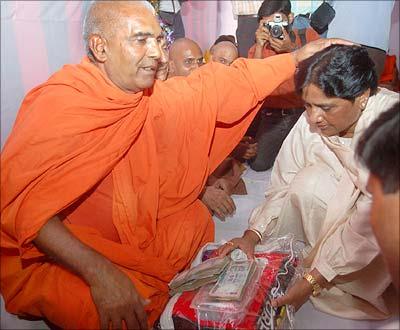
|
Mayawati: Original Inhabitant of Jambudvipa that is The Great Prabuddha Bharath ’queen’, now Brahmin messiah |
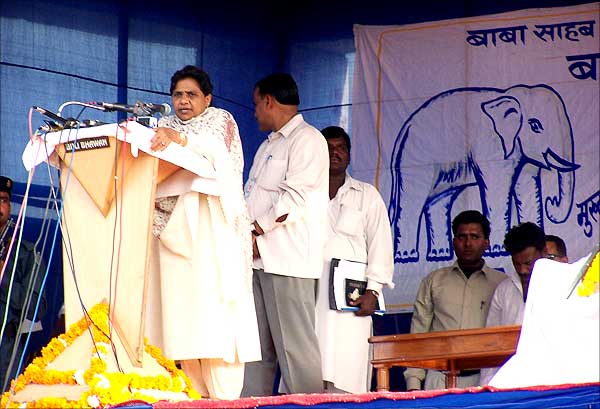 |
|
Chhatrapati Shahu Maharaj
|
 |
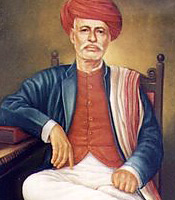
April 141891 – December 6 1956
 |
||
| Uttar Pradesh Chief Minister Mayawati said her aim is to make Uttar Pradesh an Uttam and Khushhal Pradesh. (Image: Sanjay K Sharma) |
||

|
Mayawati: Original Inhabitant of Jambudvipa that is The Great Prabuddha Bharath ’queen’, now Brahmin messiah |
 |
|
Chhatrapati Shahu Maharaj
|
 |

April 141891 – December 6 1956
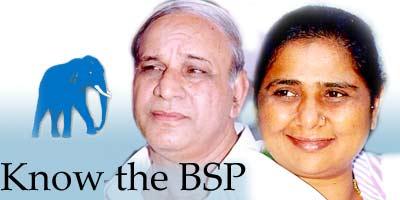
 |
 |
 |
|
Honb’le Km. Mayawati Future Prime Minister of Jambudvipa, that is the Great Prabuddha Bharath |
Two Thousand Nine !
Will Be Mine !
- Says Ms Mayawati Bahen !



